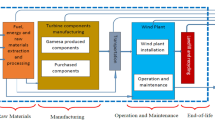Abstract
This paper primarily focuses on a systematic top-down approach in the structural and feasibility analysis of the novel modular system which integrates a 5 kW wind turbine with compressed air storage built within the tower structure, thus replacing the underground cavern storing process. The design aspects of the proposed modular compressed air storage system (CAES) were executed to eliminate the multistage air compression process and overcome the adverse safety issues of underground caverns prevailing in the conventional system. Moreover, the waste heat treatment can be eliminated owing to its low-pressure operation (8 bar max) which reduces the complexity of the system. A detailed structural analysis was conducted for the foundation, tower structure, storage chamber and wind blades using the Structural Analysis and Designing Program (STAADPRO) and Analysis System (ANSYS) software for a basic wind speed of 180 km/hour (50 m/sec) as per the IS 875 (Part 3): 2015. Certainly, the results proved that the system remained stable at its natural and sub-harmonic frequencies. However, to ensure the feasible operation of the concept, a prototype model was tested for wind speeds starting from 3 m/s and was found to compress up to a maximum of 8 bar pressure.
Graphic abstract








Similar content being viewed by others
Data availability
On request the data can be provided.
Abbreviations
- A:
-
Swept rotor area (m2)
- Am :
-
Area of foundation mat (mm2)
- c:
-
Compression (kN)
- CAES:
-
Compressed air energy storage
- Cp:
-
Power Coefficient
- D :
-
Blade diameter (m)
- d:
-
Inner diameter of cylinder (m)
- fN :
-
Natural frequency of tower
- I L :
-
Transient peak current during starting(A)
- K:
-
Stiffness of Tower (N/m)
- M:
-
Mass of Structure with cylinder (kg)
- N:
-
Shaft Speed (rpm)
- Np :
-
No. of pile structures
- Nm :
-
Motor speed (rpm)
- P:
-
Internal pressure (bar)
- Ρ:
-
Air Density (kg/m3)
- Pa:
-
Pascal
- Pcomp:
-
Pressure in compensating system (bar)
- Pe :
-
Electrical power (W)
- Qnu :
-
Soil capacity(kg/m2)
- Qu :
-
Ultimate Pile bearing capacity(kg/m2)
- R:
-
Radius of rotor
- rpm:
-
Revolutions per minute
- t:
-
Cylinder wall thickness (m)
- T:
-
Tension (kN)
- TSR:
-
Tip Speed Ratio
- Tst :
-
Starting Torque (Nm)
- V:
-
Actual Wind speed (m/s)
- Vb :
-
Basic wind speed (m/s)
- V L :
-
Line voltage (V)
- Vz :
-
Design Wind speed (m/s)
- W:
-
Wind Power (W)
- WRA:
-
Wind Resource Assessment
- σH :
-
Cylinder hoop stress (Pa)
References
Ahlen C (2009) Pile Foundations-Short hand book. Chalmers University of Technology, Gothenburg
Budt M, Wolf D, Span R, Yan J (2016) A review on compressed air energy storage: basic principles, past milestones and recent developments. Appl Energy 170:250–268
Burton T, Sharpe D, Jenkins N, Bossanyi E (2001) Wind energy Handbook. Wiley, England
Das BM (2007) Principles of foundation engineering, 6th edn. Cengage Learning, New Delhi
Hartmann N, Vohringer O, Kruck C, Eltrop L (2012) Simulation and analysis of different adiabatic compressed air energy storage plant configurations. Appl Energy 93:541–548
Koohi-Kamali S, Tyagi VV, Rahim NA, Panwar NL, Mokhlis H (2013) Emergence of energy storage technologies as the solution for reliable operation of smart power systems: a review. Renew Sustain Energy Rev 25:135–165
Mohamad C, Gallego M, Sébastien P, Mohand T (2019) Micro-scale trigenerative compressed air energy storage system : modeling and parametric optimization study. J Energy Storage 26:100944
Nabat MH, Zeynalian M, Razmi AR, Arabkoohsar A, Soltani M (2020) Energy, exergy, and economic analyses of an innovative energy storage system; liquid air energy storage (LAES) combined with high-temperature thermal energy storage (HTES). Energy Convers Manage 226:113486
Najjar YSH, Abubaker AM (2016) Using novel compressed-air energy storage systems as a green strategy in sustainable power generation: a review. Int J Energy Res 40(12):1595–1610
Perazzelli P, Anagnostou G (2016) Design issues for compressed air energy storage in sealed underground cavities. J Rock Mech Geotechn Eng 8:314–328
Roushenas R, Razmi AR, Soltani M, Torabi M, Dusseault MB, Nathwani J (2020) Thermo-environmental analysis of a novel cogeneration system based on solid oxide fuel cell (SOFC) and compressed air energy storage (CAES) coupled with turbocharger. Appl Thermal Eng 181:15978
Soltani M, Nabat MH, Razmi AR, Dusseault MB, Nathwani J (2020) A comparative study between ORC and Kalina based waste heat recovery cycles applied to a green compressed air energy storage (CAES) system. Energy Convers Manage 222:113203
Sun H, Luo X, Wang J (2015) Feasibility study of a hybrid wind turbine system–Integration with compressed air energy storage. Appl Energy 137:617–628
Wang J, Ma L, Kunpeng Lu, Miao S, Wang D, Wang J (2017) Current research and development trend of compressed air energy storage. Sys Sci Control Eng: an Open Access J 5(1):434–448
Zhao P, Dai Y, Wang J (2014) Design and thermodynamic analysis of a hybrid energy storage system based on A-CAES (adiabatic compressed air energy storage) and FESS (flywheel energy storage system) for wind power application. Energy 70:674–684
Funding
Received fund from National Institute of Wind Energy – R&D/ CF/GEN/WDASS/2017.
Author information
Authors and Affiliations
Corresponding author
Ethics declarations
Conflict of interest
The authors declare that they have no conflict of interest.
Additional information
Publisher's Note
Springer Nature remains neutral with regard to jurisdictional claims in published maps and institutional affiliations.
Rights and permissions
About this article
Cite this article
Ammal Dhanalakshmi, M., Deivasundari, P. Modular compressed air energy storage system for 5kw wind turbine: A feasibility study. Clean Techn Environ Policy 23, 2201–2212 (2021). https://doi.org/10.1007/s10098-021-02127-7
Received:
Accepted:
Published:
Issue Date:
DOI: https://doi.org/10.1007/s10098-021-02127-7




